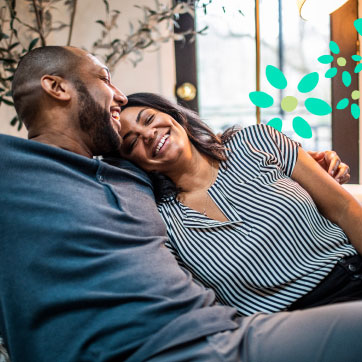The best down payment: How much is enough?
August 17, 2022 • 11 minute read
The best down payment: How much is enough?

Let’s start with a dose of reality. Homes are expensive. Prices hit record highs in the past two years and now interest rates are also rising. It’s a difficult time for almost anyone to buy a home, but it’s especially difficult for first-time homebuyers who don’t have the funds from a previous home sale to support their new purchase.
In March 2021, Washington state homebuyers needed an average $76,800 in cash to buy a home with a 10% down payment and an average 3% in closing fees, according to the National Association of Realtors, and prices have only gone up since then.
However, the question is: Do you really need more than $76,000 in down payment cash to buy a home and get a mortgage?
It’s complicated, but the short answer is, no, your down payment doesn’t need to be that much.
But should it be? Maybe.
Depending on your goals and finances, there are many ways to buy a home and they don’t always involve throwing everything you have into that initial down payment. So, let’s look at best practices, the goals you should strive to reach, realistic alternatives, and a few exceptions to the rules.
Best practices and the 20% rule
You’ve probably heard that 20% of the home price is the recommended down payment amount. That’s because Fannie Mae and Freddie Mac, the two Congress-created organizations meant to insure mortgages, require a 20% down payment to back a mortgage and protect lenders from defaults. It’s a way of keeping money in the system. Insuring mortgages mitigates lenders’ risks, allowing them to lend more money so homebuyers can continue to borrow more and buy more.
Because Fannie Mae and Freddie Mac back a majority of mortgages, the 20% down payment has become a standard goal, at least in theory, and includes a major incentive for buyers. When Fannie Mae or Freddie Mac insures your mortgage, you don’t have to.
If your mortgage is not insured by either of these institutions, or any other institution, you may be required to pay your own insurance. The most common type is called private mortgage insurance (PMI). This additional insurance payment is an extra cost that is usually added to your monthly mortgage payment. According to Freddie Mac, you can expect to pay a PMI of anywhere from $30 to $150 each month for every $100,000 borrowed.
Here's the good news: If you have a conventional loan, which is a loan that isn’t part of any specific government program, most lenders will drop the PMI after you reach 80% loan-to-value ratio (LTV). In other words, once you own roughly 20% equity in your home, you are no longer required to pay the additional insurance.

Realistic alternatives to 20%
If a 20% down payment doesn’t seem feasible, there are alternatives. After all, the typical down payment was 7% for first-time homebuyers in 2021, according to the National Association of Realtors.
Applying for a conventional loan with less than a 20% down payment and paying the PMI until you reach 80% LTV is a good option for people who can afford slightly higher mortgage payments and don’t want to throw all of their cash reserves into the down payment.
Many traditional banks, credit unions and other mortgage lenders offer loans for mortgages with down payments beginning at 5%. Some will go as low as 3%, and a few others will offer loans with a 0% down payment if you have good credit.
Another option might be to apply for a nonconventional loan, which is a loan that is usually offered through a government program. If you have less than 5% for a down payment and are having difficulty finding a lender, you may be eligible for a mortgage through the Federal Housing Authority (FHA), Veterans Affairs (VA), U.S. Department of Agriculture (USDA), or other state and local government-sponsored programs. Some of these programs may even offer zero-down loans.
If you go the nonconventional loan route, just be sure to pay attention to how the fees work. Some of these loans may have higher-than-usual fees and be more expensive than other loans in the long run. For example, if your loan is through the FHA, you may be required to pay a mortgage insurance premium (MIP), their equivalent of a PMI, for the life of the loan, long after you reach 20% equity. At the same time, one of these programs may be exactly what you need to get your foot through the door of homeownership and equity building.
When you have a choice: advantages of higher down payments
If you are still struggling to come up with an exact down payment number and are weighing your options, there are generally more reasons to put down more instead of less, especially if you plan to own your home for several years. Even a 1% increase in down payment can make a difference in your mortgage.
Some advantages of higher down payments:
- The total loan amount is lower and the monthly mortgage payment is lower.
- The lower the amount owed, the lower the total interest payment — in short, the home costs less.
- Lenders may view your mortgage as less risky, giving you more lenders to choose from and more options to negotiate rates.
- If you have a monthly mortgage budget, you can get a more expensive home with a higher down payment.
- With a high down payment and good credit, you may be able to negotiate for a better interest rate.
- A high down payment could give you an advantage in a bid — according to the National Association of Realtors, 10.8% of lost bids in the first quarter of 2021 were due to offers with higher down payments.
In general, paying as much as you can, even if that amount is less than 20%, is a good idea, especially if you plan on keeping your home for a while. The more you put down, the less you will pay over the life of the loan.

One caveat: prioritize reserves
A high down payment may be goal-worthy in many situations, but it simply may not make sense for you. If a down payment cuts into your reserve fund, go lower.
Begin by trying to anticipate what you might need. Furnaces break, roofs need to be replaced, and termites have been known to quietly eat away at the structural wood of a house, only to be discovered after extensive damage has been done. At some point, you’ll probably need to make an expensive repair, and you’ll need cash on hand to do so. Tying all of your money into a down payment for higher equity in your home might mean not having the available cash for unexpected bills or emergencies. Consider how much cash reserves you might need, then determine a realistic down payment.
If you decide to go with a lower down payment, it may be helpful to remember that the resulting larger loan may not create a significant difference in your monthly mortgage payments. The home will cost more in the end, but dividing a large sum of money into monthly payments over thirty years might make the extra cost manageable and tolerable. On a month-to-month basis, it may not feel like much of an additional burden.
When less is more
Smaller down payments might also be strategic if you are considering short-term living arrangements or thinking of your home as a short-term investment. Even with a PMI, you could get a good rate of return if the home quickly increases in value and then is sold. But there are risks. There is no guarantee the home will increase in value, and there is no guarantee it will sell when you want. The longer you own your home, the more likely your high monthly mortgage payments will negate any benefit you gained from a small down payment.
We’re here to help.
We’re here to help.
We know every first home purchase is unique. At WSECU, we’ll walk you through the home-buying process and help you develop a payment strategy that is smart and realistic.
